| Please feel free to e-mail this article to a friend, a principal, a parent, a colleague, a teacher librarian, a college professor, a poet, a magician, a vendor, an artist, a juggler, a student, a news reporter or to anyone else you think might enjoy it. |
A Focus on History, Literacies and ICT
By Jamie McKenzie, ©2010, all rights reserved.
About author
In 1984, Jamie earned his Ed.D. from Rutgers in social studies education and was at one time chair of the curriculum committee of the National Council of the Social Studies (USA).
|
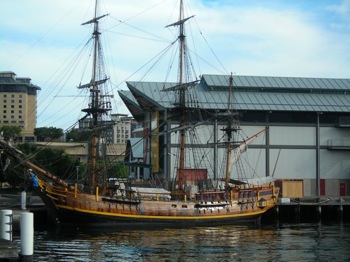 Was Bligh guilty? of what?
Was Bligh guilty? of what?
Who showed more courage? Bligh? Cook? Flinders?
|
Sparking Students' Curiosity and Imagination
For decades in many classrooms around the world, history and the social studies have been rated as pretty boring by many students, so it is refreshing when Australia sets national history goals that start right off with the goal of stimulating ". . . students' curiosity and imagination." (Download PDF)
in Christine Halse's research (1995) into the state of history in NSW secondary schools, one student was quoted as follows:
"We did Australian history in years 3, 4, 5, 6, 7, 8 and 9," complained one student. "It was boring. I would rather watch paint dry."
Such findings were echoed in Tony Talylor's The Future of the Past — The Final Report of the National Inquiry into School History.
- The other problems I found as a primary school teacher going into high
school is quite often I have children who have done “Gold” twice –
sometimes three times, “Aborigines” every second year and the
perception on coming into high school was “Oh it’s boring”. Doesn’t
have interest. (p. 80)
Secondary School Teacher
It should be noted that history is met with the same dismay in many countries. In the USA, for example, Loewen states in Lies My Teacher Told Me that ". . . high school students usually say history is their least favorite subject, and that when ranking 21 high school subjects from most to least relevant, students rank history dead last." (pp. 12-13).
The challenge of sparking students' curiosity and imagination is HUGE - as traditional methods of teaching history have left little to the imagination and have confronted students with the equivalent of completed jigsaw puzzles. The young have passed through school usually being told by teachers, textbook writers and historians what happened in the past and why it happened. Little mystery is left to puzzle over. Even though many adults may argue furiously over what happened in the past — note the History Wars in Australia — contention, debate, controversy and wrangling are rarely allowed to enter the history classroom.
Tony Talylor's The Future of the Past makes this condition clear for Australia, but the same approach is typical in many history classrooms around the world. Fortunately, there have always been teachers who have found much better ways to engage the young in historical discovery and dispute, employing strategies like the ones this article will propose. Chapter Six of Taylor's report outlines successful practices found in a number of schools in Australia - a chapter very much worth reading in conjunction with this article.
Taylor's chapter mentions the exemplary approach of one Michael Carson, for example, a teacher at Cookhill Primary School. He is quoted at some length listing key strategies, but the following paragraph stood out:
- Think of history as a verb, not a noun. One of the things I remember from my own education was that history was very much something that was studied by others and, in the classroom, children were expected not to learn ”history” but to read the product of someone else’s research, and re-present this in their own words. Surely what you want to give children are the skills, knowledge and desire to research history for themselves. Certainly there are important pieces of knowledge to which all children should be introduced but these (facts) must have a reason for children to study them. They must provide children with a reason to internalise them. (p. 109)
Learning from Past Efforts
In one way or another, I have been teaching history since 1967, when I first left university. I was fortunate to enter teaching at a time when inquiry learning was extremely fashionable, and we even had something in the States called "The New Social Studies." As Taylor points out in his report, good teaching of history is nothing new. The problem lies in its rarity and its fragility. Many of the tenets of the new Australian National History Curriculum were honored by the inquiry movements of the 1960s and 1970s, but as so often happens with such fashions in education, inquiry and constructivist approaches to the study of history and society had a difficult time taking root. Note retrospective articles by Fenton "Reflections on the New Social Studies" and James P. Shaver "The new social studies, textbooks, and reform in social studies." Shaver states:
- The New Social Studies curriculum development movement was short-lived, in part because project staff were not sensitive to the realities of the educational context within which their materials and methods would be used. Although textbook-based recitation persists in social studies classrooms, textbooks are not a ready mechanism for reform. Among the reasons are the institutional constraints on publishers and the difficulty in effecting curricular change without appropriate teacher preparation and modifications in the educational environment.
While the tenets of the new Australian History Curriculum are admirable and the outcomes desirable, those who hope to implement the curriculum should study past efforts, so as to avoid repeating the same mistakes.
- "Those who cannot remember the past are condemned to repeat it." George Santayana
More than a Dozen Strategies to Bring History to Life
The list of strategies below propose bold stroke approaches that can be readily applied by classroom teachers without too much fuss and bother. Many have been around for decades but are too rarely practiced.
Each strategy promises to bring one or more of the basic tenets of the Australian Curriculum to life in a reasonable and practical fashion. The hands-on workshop designed to accompany this article will engage participants in actually tasting some of these strategies as learners.

| Primary Sources
School history sometimes depends too much upon textbooks and secondary sources that have done all the thinking and squeezed the mystery out of the stories. In an effort to present the past in an orderly fashion, these sources often create a false sense of clarity, oversimplifying complex events, replacing fog with clarity and turning complicated human beings into icons.
While there may be problems with reading levels, students learn quickly by reading the documents of the past that truth is a bit elusive and history can be as much fun as a Sherlock Holmes mystery.
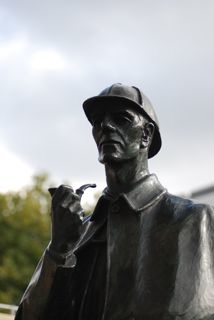
How did Captain James Cook treat the native people he encountered? Was his approach to them typical of his times? How would you judge him from the point of view of modern values? Is that fair?
The selection to the right is a sample of what is available from Project Gutenberg, a site that offers thousands of old texts and some wonderful primary sources such as Captain Cook's Journal During the First Voyage Round the World
To make a judgment about Cook's handling of the native people, students would have to read more than one encounter and would have to consider the wisdom of relying on his own accounts of these incidents, for primary sources can be distorted as badly as secondary.
|
In Cook's own words . . .
. . 
Thursday, 19th. Gentle breezes and fair weather. Employ'd getting everything in readyness for Sea. A.M., we were Visited by 10 or 11 of the Natives; the most of them came from the other side of the Harbour, where we saw 6 or 7 more, the most of them Women, and, like the men, quite naked. Those that came on board were very desirous of having some of our Turtles, and took the liberty to haul 2 of them to the Gangway to put over the side; being disappointed in this, they grew a little Troublesome, and were for throwing every thing overboard they could lay their hands upon.
As we had no Victuals dress'd at this time, I offer'd them some bread to Eat, which they rejected with Scorn, as I believe they would have done anything else excepting Turtle;* (* No doubt, in the native view, the turtle belonged to them, and they considered the strangers had annexed their property.) soon after this they all went ashore, Mr. Banks, myself, and 5 or 6 of our people being their at same time.
Immediately upon their Landing one of them took a Handful of dry grass and lighted it at a fire we had ashore, and before we well know'd what he was going about he made a larger Circuit round about us, and set fire to the grass in his way, and in an instant the whole place was in flames. Luckily at this time we had hardly anything ashore, besides the Forge and a Sow with a litter of young Pigs, one of which was scorched to Death in the fire.
|
| Debunking
Students may enjoy the process of challenging the statements and judgments they encounter when studying history. A teacher can show them a particularly dubious bit of writing and ask them to gather evidence that might debunk the statements.
Several years ago I found such a passage on the Canadian National Library site that has since been withdrawn — reproduced on the right.
While Cook was remarkable, he was human and quite fallible. There is ample evidence of his hostage taking and his disciplinary excesses to support the debunking process, whether students use his own accounts as evidence or turn to a source like Trial of the Cannibal Dog by Anne Salmond.
|
- "Many believe that Captain James Cook was the greatest ocean explorer ever to have lived, and that he mapped more of the world than any other man."
"He also set an example of how to treat a ship, its crew, and the people he met on his explorations."
- Quoted from Passageways: True Tales of Adventure for Young Explorers at http://www.nlc-bnc.ca/explorers/kids/h3-1710-e.html
|
| 20/20 Hindsight
While it may not be fair to take a new look at decisions made in the past, it can be an entertaining and valuable exercise for students. Given what we know now, how might we advise the king of France to save his neck?
The teacher hands out the following assignment:
"Some historians suggest that Louis XVI was brought down in part by hunger and starvation. Imagine you and your team members are advising the king in the years from 1785-89. How should the King address the issues of hunger and starvation as well as taxation and wheat speculation?"
As they read about taxation in France coupled at the time with speculation driving up the price of wheat, they begin to formulate changes in policies that might have saved the king from the guillotine. The king lacked foresight. Students have the advantage of 20-20 hindsight.
|

Students consult sources such as The Project Gutenberg EBook of The French Revolution, by R. M. Johnston at http://www.gutenberg.org/files/19421/19421-8.txt.
- But popular resentment, the bitter cry of the starving, applied the same name to all of
them:
-
- . . . from Louis XV to the inconspicuous monk they were all accapareurs de blé, cornerers of wheat. And their profits rose as did hunger and starvation. The computation has been put forward that in the year 1789 one-half of the population of France had known from experience the meaning of the word hunger; can it be wondered if the curse of a whole people was attached to any man of whom it might be said that he was an accapareur de blé?
|
| What if?
The way history is often taught, there is little room for speculation or wondering. The story of past events is told as if set in concrete, yet the actual events may have hung in a more tenuous balance.
Students might be asked to ponder the consequences of major reversals or shifts.
What if the French or the Dutch had been more aggressive and made Australia their own instead of the British? How do you think modern day Australia might be different?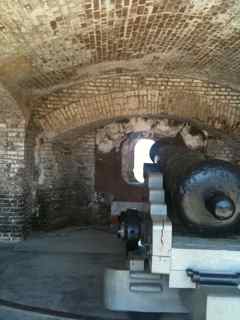
What if the settlement of North America, New Zealand and Australia by Europeans had been conducted without warfare and conflict with native people?
|
A favorite "What if?" activity of American history teachers would be "What if the South had won the Civil War?" But there are so many more possibilities.
What if JFK or MLK had not been assassinated?
What if the US had not invaded Iraq?
What if Congress would have regulated the banking industry during the past decade?

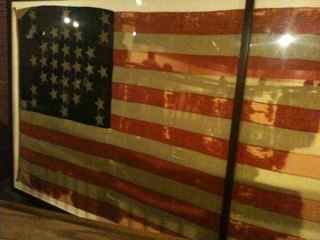
Photos of Fort Sumter, © 2010, J. McKenzie
What if Britain had not used convicts to help with the settlement of Australia? How do you think modern day Australia might be different?
|
| Character Study
In many history classrooms, the important people and leaders are presented with about as much humanity and drama as figures in a wax museum. They are turned into rather boring stick figures — icons, if you will, who bear little resemblance to their real selves. Put up on pedestals and given statues, their heroism and grandeur is puffed up beyond reality, or, in the case of figures like Bligh and Benedict Arnold, they are turned into utter villains.
Most of these figures stumbled, slipped and made plenty of bad decisions during their careers, but these are often discarded and ignored when their stories appear in text books or histories — unless, of course, they are viewed now as villains, in which case, their vices, their missteps and their treacheries are usually exaggerated while their good qualities are overlooked.
Students usually find the unmasking of these characters quite intriguing. By reading primary sources like Matthew Flinders' letters to his wife, they can form their own judgments about his character rather than relying upon the interpretations of historians and textbook writers.
In some cases, they might even find themselves correcting inaccuracies in a Wikipedia biography.
|
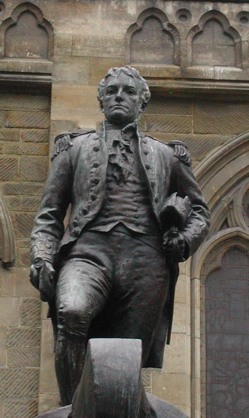 Photo of Matthew Flinders statue © J. McKenzie
Photo of Matthew Flinders statue © J. McKenzie
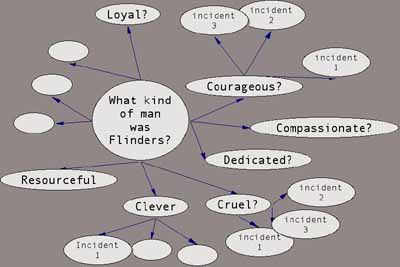
A character study might begin with some light background reading — a brief summary of Matthew Flinders's career as naval officer and explorer such as a sketch of dubious accuracy at Wikipedia. Once students have a little background, they are challenged to list suppositions about his character, shown above as questions. Was he arrogant? Cruel? Courageous?
Students then read his letters to his wife to gather evidence to substantiate or repudiate their reasonable guesses. The collection at the National Maritime Museum (UK) provides ample corroboration or refutation.
|
| Adviser
In the section above on 20/20 Hindsight, students were asked to advise King Louis on how to escape the guillotine. There are thousands of opportunities to engage students in such thinking, whether they will help Custer to avoid his last stand or Shanghai and Singapore their collapse under the attack of the Japanese in World War II. In each case, students are encouraged to think that historical events may be shaped by good decision-making rather than relying upon luck and happenstance. It is important that students have a chance to view each of these decisions from the point of view of the nation or culture facing the problem or challenge, setting aside for the exercise their American, Australian or Chinese points of view to try on the standpoint of the group wrestling with the issue.
Acting as advisers to the US government and JFK in 1963, students might ponder the options. "What should the US do to handle the threats and opportunities represented by Vietnam?"
|
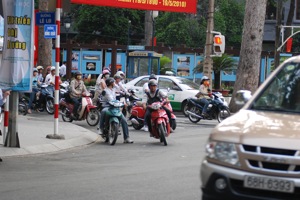
Photo of Saigon in 2010 © J. McKenzie
Saigon 1963
In the opening months of JFK's presidency, he made some very important decisions about the war in Vietnam. Even though the photograph above was shot in Saigon this May of 2010, it represents the intersections and choices that face decision-makers at crucial points in history.
It took another decade, an assassination, a hundred thousand American deaths, many more Vietnamese deaths and two different presidents to end the US involvement in Vietnam.
Acting as advisers to Ho Chi Minh in 1963, students might ponder the options. "What should you do to drive the foreigners out of Vietnam once and for all?"
Acting as advisers to President Ngo Dinh Diem of South Vietnam in 1963, students might ponder the options. "What should you do to keep Ho Chi Minh and his Viet Cong from gaining control of the country?"
Acting as advisers to the Australian government in 1963, students might ponder the options. "What should Australia do to handle the threats and opportunities represented by Vietnam?"
|
| Interview
One student plays the part of the figure from history and must do enough research to answer any questions posed by the class. In order to move past the obvious factoids like "When were you born?" a team of student interviewers works to find out the person's greatest and worst moments. They know enough to select from the Biography Questions of Import.
1. What human qualities were most influential in shaping the way this person lived and influenced his or her times?
# Which quality or trait proved most troubling and difficult?
2. Which quality or trait was most beneficial?
3. Did this person make any major mistakes or bad decisions? If so, what were they and how would you have chosen and acted differently if you were in their shoes?
4.What are the two or three most important lessons you or any other young person might learn from the way this person lived?
5. Some people say you can judge the quality of a person's life by the enemies they make. Do you think this is true of your person's life? Explain why or why not.
|
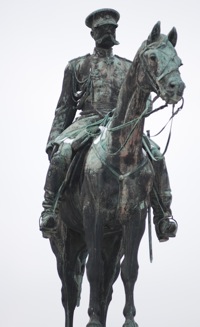 This statue of Tzar Nikolai "the Liberator" of Russia in the center of Sofia, Bulgaria struck my eye when visiting in February. It depicts his "liberation" of Bulgaria from the Turks during the Russo-Turkish War of 1877-78. This statue of Tzar Nikolai "the Liberator" of Russia in the center of Sofia, Bulgaria struck my eye when visiting in February. It depicts his "liberation" of Bulgaria from the Turks during the Russo-Turkish War of 1877-78.
If we had him in the room on the interview couch, we might ask questions like the following:
- Why did you decide to free Bulgaria from the Turks?
- How much did it cost you and Russia?
- Is there anything you would change in the way you conducted the war?
- What would you predict about the future of Bulgaria?
- Do you think of Bulgaria as belonging to Russia?
- How do you want history to remember you?
- What is the most important part of your job as Emperor?
- What are the greatest weaknesses of your Empire?
- What are you doing to meet those problems?
- How will you die?
|
| Mystery
In all too many classrooms, the mystery has been wrung from the past as historians and textbook writers have filled in the blanks and erased the mysteries with their own speculations and guesswork. Their tone is often quite imperious, as if they know all the answers and cannot be challenged, and yet one can often find a contradictory point of view or explanation for the same events offered with the same level of certainty by a different writer. There are some mysteries that will remain unsolved despite the best efforts of historians because we simply do not have enough reliable information to draw sustainable conclusions. Fortunately for historians, few readers seem eager to probe past the superficial certainties put forth by the historians, so they are given a free pass.
|
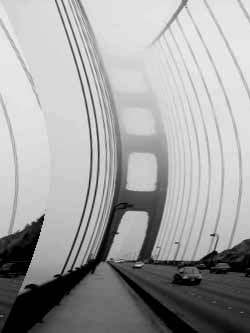 So much of history is shrouded in fog much like this blanket I captured on a morning run across the Golden Gate Bridge. So much of history is shrouded in fog much like this blanket I captured on a morning run across the Golden Gate Bridge.
This image was further distorted in PhotoShop™ to represent the distortions almost always present as we look at events of the past.
Good teachers of history will help students to identify the mysteries — and to appreciate them. We will never know for sure, for example, what Joan of Arc said at her first trial because there were several different men recording those words and some of them complained in a later trial that the official transcript differed from what they recorded.
Ironically, the search for truth is better served by honestly confronting the fog and the mystery rather than imposing an interpretation or view that is artificial.
|
| Trial
Questions of guilt and innocence can provoke a great amount of curiosity, passion and interest. In the case of Captain Bligh, there were two trials for Mutiny, though most folks only know about the mutiny on the Bounty. There was yet another when Bligh tried to cut off the lucrative rum trade in Sydney when he was Governor there and the troops rebelled in what is now called the Rum Rebellion. Bligh was acquitted of charges in both of these cases, but he has the distinction for setting a record of sorts. A class might put him back on trial, or even more fascinating potentially, they might retry the officers and seamen recovered once the mutineers were caught and returned to Britain.
While these trials can be motivating, they can also stir parental and community anger as some would prefer we leave the dark moments of our past unexamined. The very act of questioning those times and events can be painted as unpatriotic, disloyal and Marxist. Some have called such study the "black armband" approach.
|
Preparing for a trial requires a great deal of research as witnesses and the accused must know enough about the events to handle the courtroom questioning with knowledge and assurance. But it is more than events. These witnesses must be able to act in character. If they land a big part like Bligh, himself, then they must study his mannerisms as well as the events, perhaps watching several movies to get some inspiration as well as reading first hand accounts from those times. Movies, of course, are often guilty of distortion and must be viewed with a shaker of salt.
There are so many characters from history we might put on trial, whether it be Custer or Sitting Bull, the early settlers, the native people guilty of massacre or the merchants who exploited their customers. When soldiers were guilty of massacre or torture, should the officers be on trial or just the enlisted troops?
|
| Suppose
When we ask students to suppose something about events in history, we engage them in conjecture - theory-building, wondering and considering possibilities. These are challenges that call for the imagination envisioned by the Australian National Curriculum.
|
- Why do you suppose so many people in Britain signed contracts as indentured servants to work in Australia and America?
- Why do you suppose so many people in Britain were able to go to church, believe in the Bible but also support the slavery system?
- Why do you suppose people like Matthew Flinders and Robert Bligh chose to spend so much of their lives exploring the uncharted regions of the world?
- Why do you suppose some historians twist the truth?
|
| Journal
Students may feel more engagement with the events they are studying if called upon to write a journal as if they were a participant in the events — not a world leader or Great Person — but a regular citizen, one of those men or women who served as grunts and foot soldiers, guards, cooks, nurses, seamstresses, field hands and bottle washers.
|
Imagine you were a Marine serving on one of the first ships carrying convicts from Britain to Australia in 1788.
Create a journal with 20 or more entries describing your voyage, the conditions you endured and some of the events that took place.
Background information on the "First Fleet" (1788)
|
| Case Study
Case Studies present students with situations from the past that ask them to develop a plan of action to address a challenge.. This approach has been used for many years to help students understand principles of law, for example. In the U.S. some publishers have provided legal cases related to the Bill of Rights and asked students to wrestle with the issues involved in a real human situation. Take a look at the listing at Social Studies School Services.
|
This approach has been used in many of the Australian projects listed in Indigenous Case Studies at The Civics and Citizenship Education web site sponsored by the Australian Government Department of Education, Employment and Workplace Relations, and maintained by Curriculum Corporation.
|
| Role Play
As with case studies, role play puts students in the job or situation of individuals from the past and asks them to act out an experience. This approach can place them high on the social ladder as a leader or lower down as a settler, a store owner or a drover. Students must learn enough about the lives they are playing so they can represent them with both skill and empathy.
|
Make a Newspaper
When students create a newspaper reporting on the most important events of a week from the past, they might combine research with imagination, combining stories they have found in old documents with editorials they have written and items they have invented. This challenge is most useful if it not a simple act of replicating a newspaper and its entries from the past.
|
|
| Debate
While traditional history classes would sometimes present the events of the past as if a nicely aligned series, the emergence of those moves and decisions often took place in fits and starts, with rumblings, eruptions, dispute, conflict, wavering, compromising and all kinds of messy missteps.
|
When students are asked to take sides on issues from the past, they are given a taste of the turmoil and complexity of the past. They come to see how it resembles the present. Things are not neat and tidy and never have been. Events stumble and stagger as folks argue over what should be done. |
|
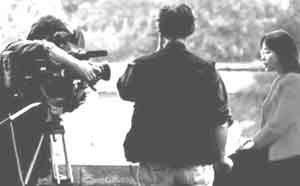
Make a Movie
Many middle schools and high schools have the technology to support movie making — an excellent way to bring history to life as students must research costumes, create a script and dramatize an event from the past in a convincing manner. This is, after all, a YouTube generation. Check out BestFest America's Forum of student films.
|
USA Example: Student Video Projects
Urban Dreams (1999 - 2004)
Urban Dreams was a project of the Oakland Unified School District Office of Instructional Technology. It was funded by a five-year Federal Technology Innovation Grant awarded in 1999. The project was designed to support the work of History and English teachers, grades 9-12, by providing access to appropriate technology tools and professional development opportunities.
Australian Example:
Projects reported in School Connections: Using ICT to engage students in learning (PDF)
Spinning a Yarn — Taking a byte into high school used documentary filmmaking techniques through collaboration and cooperative teaching and learning. Students were encouraged to spin a yarn about a local story through the production of a 5 minute short film.
|
|

Everyday People
Traditional approaches to the study of history have tended to stress the actions of so-called great leaders while paying scant attention to the lives of everyday people. Student engagement is increased when they are able to identify with the people who lived through the times, so historical fiction, films, journals and first person accounts can breathe life into events that might otherwise seem abstract and distant when covered by a dry textbook.
|

The German invasion of France and the ensuing flight of citizens from Paris comes to life on the pages of Suite Francaise by Irène Némirovsky:
- The first to hear the hum of the siren were those who couldn’t sleep- the ill and bedridden, mothers with sons at the front, women crying for the men they loved. To them it began as a long breath, like air being forced into a deep sigh...it came from afar...slowly, lazily...they still dreamed of waves breaking over pebbles, a March storm whipping the woods...until finally sleep was shaken off and they struggled to open their eyes, murmuring “Is it an air raid?”
|
|
| Comparison
Things become more interesting when students are asked to compare and contrast people, events or ideas from history. Instead of merely collecting nuggets of information, the students must use information to form a judgment.
- Which of the following ship captains treated native people with the least decency? Bligh? Cook? Flinders?
- Which of the following convict settlements was the hardest on prisoners? Norfolk Island? Van Diemen's Land? Port Macquarie? Moreton Bay?
|
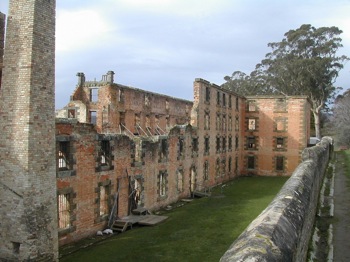
Convict Quarters - Port Arthur
The harsh treatment included long stints on treadmills and whippings. U2's song, "Van Diemen's Land," tells the story of those exiled to Tasmania. A new movie dramatizes the escape of convicts in Van Diemen's Land.
|
| Simulate
Simulations are much like case studies and role-playing, but they tend to be more extensive enactments of events of the past with key players asked to make decisions. One leading producer of such historical simulations — Tom Snyder Productions, Inc. — calls their series, "Decisions, Decisions." Their simulations are computer based to help generate outcomes in response to student choices.
An example of this approach applied to Australian history would be Australian Federation, 1901
A set of study materials for Years 7-10 Australian History
|
Decisions, Decisions 5.0 consists of the following titles:
* Ancient Empires
* Feudalism
* Building a Nation
* The Constitution
* Immigration
* Colonization
* Revolutionary Wars
* The Environment
* The Cold War
* Prejudice
* Lying, Cheating, Stealing
* On the Campaign Trail
* Town Government
* Substance Abuse
* Violence in the Media |
The Australian National History Curriculum lists the following aims which this article has meant to address:
Aims
The Australian Curriculum: History K-10 aims to develop in each student:
- Interest in, and enjoyment of, historical study for lifelong learning and work, including their capacity and willingness to be active and informed citizens
- Knowledge, understanding and appreciation of the past and the forces that shape societies, including Australian society
- Understanding and use of historical concepts, including evidence, continuity and change, cause and effect, significance, empathy, perspectives and contestability
- Capacity to undertake historical inquiry, including skills in the analysis and use of sources, communication and explanation. (Download PDF)
-
|
|
Copyright Policy: Materials published in From Now On may be duplicated in hard copy format if unchanged in format and content for educational, nonprofit school district and university use only and may also be sent from person to person by e-mail. This copyright statement must be included. All other uses, transmissions and duplications are prohibited unless permission is granted expressly. Showing these pages remotely through frames is not permitted.
FNO is applying for formal copyright registration for articles.
|
|
|



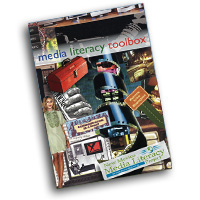









 This statue of Tzar Nikolai "the Liberator" of Russia in the center of Sofia, Bulgaria struck my eye when visiting in February. It depicts his "liberation" of Bulgaria from the Turks during the Russo-Turkish War of 1877-78.
This statue of Tzar Nikolai "the Liberator" of Russia in the center of Sofia, Bulgaria struck my eye when visiting in February. It depicts his "liberation" of Bulgaria from the Turks during the Russo-Turkish War of 1877-78.
 So much of history is shrouded in fog much like this blanket I captured on a morning run across the Golden Gate Bridge.
So much of history is shrouded in fog much like this blanket I captured on a morning run across the Golden Gate Bridge.




